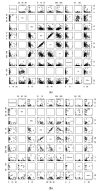14-3-3 η Protein as a Potential Biomarker in Juvenile Idiopathic Arthritis
- PMID: 33504004
- PMCID: PMC7844622
- DOI: 10.3390/pediatric13010008
14-3-3 η Protein as a Potential Biomarker in Juvenile Idiopathic Arthritis
Abstract
The 14-3-3η (eta) protein was evaluated as a biomarker in a cohort of patients with juvenile idiopathic arthritis (JIA), as well as disease- and healthy-controls, to determine its potential clinical utility. In this case-control study, levels of 14-3-3η protein were evaluated in archival specimens from patients with JIA, systemic lupus erythematosus (SLE), and rheumatoid arthritis (RA), as well as healthy pediatric controls. Just over 200 patients were evaluated, using specimens banked between 1990 and 2011. Comparisons were made to complete blood cell count (CBC), erythrocyte sedimentation rate (ESR), C-reactive protein (CRP), rheumatoid factor (RF), anti-cyclic citrullinated peptide (anti-CCP) antibodies, and anti-nuclear antibody (ANA) positivity. 14-3-3η at levels 0.2 ng/mL or higher was considered positive. Fisher's exact tests, odds ratios, 95% confidence intervals, and p-values were reported. 14-3-3η positivity was seen in all included JIA subtypes. The rate of positivity was the highest in RF-positive (pos) polyarticular JIA. In the disease and healthy controls, lower rates of positivity were observed. The frequency of 14-3-3η positivity among RF-positive and RF-negative (neg) polyarticular JIA patients, especially at values ≥0.5 ng/mL (associated with poor outcomes in adults), was also highest. Several JIA patients with 14-3-3η positivity developed RF and anti-CCP positivity later in their disease. Significant levels of 14-3-3η can be found in approximately 30% of RF-pos and RF-neg patients with polyarticular JIA. This protein may represent a new biomarker for polyarticular JIA, particularly RF-neg polyarticular JIA.
Keywords: 14-3-3 proteins; biomarkers; juvenile idiopathic arthritis.
Conflict of interest statement
The authors declare no conflict of interest. The funders had no role in the design of the study; in the collection, analyses, or interpretation of data; in the writing of the manuscript, or in the decision to publish the results.
Figures
Similar articles
-
Prevalence and significance of serum 14-3-3η in juvenile idiopathic arthritis.Pediatr Rheumatol Online J. 2021 Feb 16;19(1):14. doi: 10.1186/s12969-021-00502-8. Pediatr Rheumatol Online J. 2021. PMID: 33593401 Free PMC article.
-
Antibodies to Cyclic Citrullinated Peptides in Patients With Juvenile Idiopathic Arthritis and Patients With Rheumatoid Arthritis: Shared Expression of the Inherently Autoreactive 9G4 Idiotype.Arthritis Rheumatol. 2017 Jul;69(7):1387-1395. doi: 10.1002/art.40117. Epub 2017 Jun 5. Arthritis Rheumatol. 2017. PMID: 28380667
-
Anti-cyclic citrullinated peptide antibodies in patients with juvenile idiopathic arthritis.Immunol Invest. 2008;37(8):849-57. doi: 10.1080/08820130802438057. Immunol Invest. 2008. PMID: 18991100
-
B Cells on the Stage of Inflammation in Juvenile Idiopathic Arthritis: Leading or Supporting Actors in Disease Pathogenesis?Front Med (Lausanne). 2022 Apr 4;9:851532. doi: 10.3389/fmed.2022.851532. eCollection 2022. Front Med (Lausanne). 2022. PMID: 35449805 Free PMC article. Review.
-
14-3-3η protein: a promising biomarker for rheumatoid arthritis.Biomark Med. 2018 Aug;12(8):917-925. doi: 10.2217/bmm-2017-0385. Epub 2018 Jul 19. Biomark Med. 2018. PMID: 30022679 Review.
Cited by
-
Inflammation-profiling reveals activated pathways and biomarkers with predictive potential in oligoarticular juvenile idiopathic arthritis.Front Immunol. 2025 Aug 7;16:1599747. doi: 10.3389/fimmu.2025.1599747. eCollection 2025. Front Immunol. 2025. PMID: 40852723 Free PMC article.
-
14-3-3 Eta protein as a novel biomarker in early detection of uveitis in Egyptian juvenile idiopathic arthritis and rheumatoid arthritis patients: Diagnostic and prognostic value.Rheumatol Immunol Res. 2025 Jan 9;5(4):217-226. doi: 10.1515/rir-2024-0030. eCollection 2024 Dec. Rheumatol Immunol Res. 2025. PMID: 39802549 Free PMC article.
References
-
- Petty R.E., Laxer R.M., Wedderburn L.R. Juvenile idiopathic arthritis. In: Petty R.E., Laxer R.M., Lindsley C.B., Wedderburn L.R., editors. Textbook of Pediatric Rheumatology. 7th ed. Elsevier; Philadelphia, PA, USA: 2016. pp. 188–203.
-
- Gilliam B.E., Chauhan A.K., Low J.M., Moore T.L. Measurement of biomarkers in juvenile idiopathic arthritis patients and their predication of disease severity: A comparative study. Clin. Exp. Rheumatol. 2008;26:492–497. - PubMed
Grants and funding
LinkOut - more resources
Full Text Sources
Other Literature Sources
Medical
Research Materials
Miscellaneous


